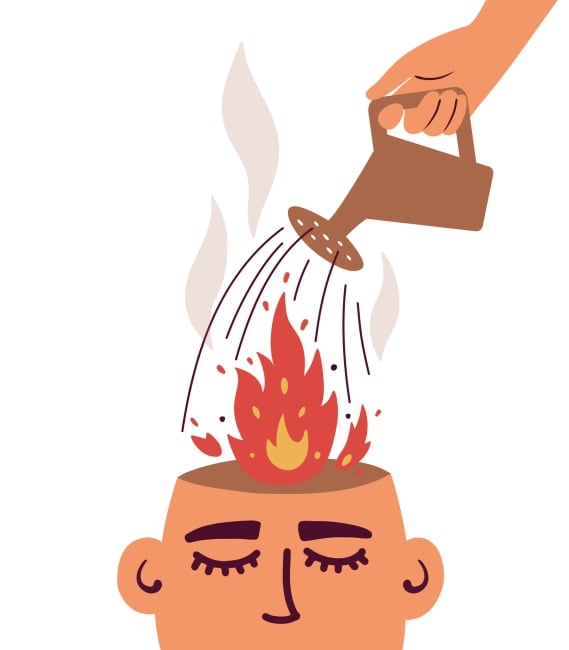You have /5 articles left.
Sign up for a free account or log in.

Olga Strelnikova/iStock/Getty Images Plus
It’s rare that a day goes by in which burnout among academics doesn’t come up in personal conversations or news reports in some way. Regularly, I recognize feelings of burnout within myself, even as a white cis woman who left a faculty position and can set my own schedule. And I regularly talk with others in higher education who are cycling through exhaustion, weariness, frustration and disappointment—if not deeper hurts.
And while burnout became a more familiar topic in the news media and otherwise during the height of COVID, and was exacerbated by it, these conditions didn’t begin with the pandemic and far exceed it. Perhaps it comes as no surprise, then, that burnout remains a central focus of the coaching work I do with academics. Many recent articles address burnout in one way or another: from discussions of burnout among health-care faculty, DEI staff and people working in community colleges to advice for educators to balance self-care with accountability.
As I shared in a previous essay, “Honoring Ourselves and Each Other Through Burnout,” burnout is more than an individual experience: “Despite being personally experienced, burnout is collectively constructed through dehumanizing systems. It cumulates as institutions and interactions signal disregard and disrespect.” The language of “burnout” is a shorthand for being “burned up” by systemic injustice, including the accumulation of everyday microaggressions, presumed incompetence and other characteristics of white supremacy culture—all of which run throughout higher education.
Burnout is also never just about burnout. Collectively and individually, our nervous systems are overtaxed by continuous crises and denial of how much violence we’re facing. Intervening into burnout, therefore, can involve actions like blocking institutional harm or moving from denial to recognition. It can also involve a lot of self-inquiry and self-work.
In order to navigate and intervene into dehumanizing systems, interventions will often require us to engage in career discernment. We may face questions of what’s in and out of our hands, where and when we can make changes, when instead we need to walk away—and why. Interventions often invite curiosity about commitments, habits and practices. They can highlight unmet needs, hurts and longings. And they can teach the wisdom that the absence of a strong yes is actually a no.
The more I learn about burnout, the more I realize how much hurt and wrongdoing underlie burnout and, therefore, how many multidirectional interventions are needed. Luckily, we can learn from how other academics are intervening into burnout. Examples of interventions can expand our sense of what’s possible.
A Continuing Need
Early in the pandemic, I really thought—well, hoped—that we collectively would shift our commitments away from going, going, going and the constant capitalist productivity pressures of “more, better, faster”—the very pressures that underlie racial capitalism and white supremacy culture. I hoped that we in higher education would scale back and allow for more spaciousness—that we’d release expectations to overextend ourselves and let go of the ever-accumulating must-dos.
Now, more than three years later, I still deeply desire change. But I’m also grieving (again) just how little has shifted and how much more exhausted, overstretched and worn thin we are today.
Certainly, we need significant and structural change. We need large-scale and long-haul interventions. We need more than individual solutions. And we are still living and working in systems that are eating away at us in the here and now, in our everyday lives.
So, how do we honor ourselves and each other through burnout?
In the rest of this article, I will offer examples of creative interventions that I am witnessing. These examples are gifted to me through coaching, so I write with deep gratitude for people who are trying different ways of being, doing, feeling, thinking, relating and imagining in higher education.
I am often asked exactly how to intervene into burnout, and I can give no one-size-fits-all answer. Instead, I find that we need many examples to spark many creative interventions. We need to ask many questions to push our creative imaginations.
So much advice on burnout suggests scaling back and saying no. And saying no can be a powerful action when we are positioned to do this for ourselves and for others, especially as a form of blocking harm. But what does it look like to say no in ways that aren’t purely individual—in ways that create space for others to say no, too? In ways that push for institutional change? In ways that shift from burning up/out toward seeking collective liberation?
What I notice about the examples in this essay is that they engage the feminist ethic of both-and: both releasing attachment to “the ways things are done” and building capacity for new ways. I have organized them into three groups: the first aligned with the advice to scale back, the second focused on changing daily rhythms and pacing, and the third working toward deeper, structural changes. Together, they invite a broader sense of what’s possible.
- Questioning norms, scaling back and disrupting “the way things are done.” Some examples:
- Proposing to the department, “We’ve always done this program annually, but could we move to a biannual cycle instead?” Or asking, “Is this program one of our core commitments? What would happen, really, if we stopped doing it?”
- Teaching fewer courses, teaching in scaled-back ways and teaching not individually but as part of collaborative groups.
- Shortening orientation from a full week to two days and shifting the focus from administrative to-dos toward relationship-building (thereby, strengthening how people can connect with each other as a teaching team, graduate cohort or other group).
- Reducing the frequency of teaching observations and having conversations about teaching instead of writing observation reports.
- Producing one-paragraph instead of one-page administrative write-ups.
- Interrupting the regular rhythm of being always on by being truly away. Some examples:
- Dropping everything for a few days of an impromptu writing retreat or wellness days.
- Insisting on having days of the week without any meetings or on-call obligations.
- Planning days throughout the semester for students to work on their own.
- Scaling back on conference participation and conference organizing, which can allow time for more conversations about what really inspires rather than drains energy.
- Scheduling regular times to check in with one’s capacity, energy level, sensations and emotions—sometimes to reset expectations, make decisions and say yes/no, and sometimes just to navigate the day, reconnect with the body and breathe through what’s hard.
- Following what inspires, building relationally and doing deeper self-work. Some examples:
- Approaching self-care as reparenting, especially unlearning patterns of rushing and overextending, releasing perfectionism and people-pleasing, and changing other long-held habits and practices.
- Seeking the support of coaches, counselors, spiritual directors, acupuncturists and other healers.
- Working with affinity groups and colleagues who organize and advocate for recognizing each other, building solidarity and mobilizing a critical mass to create changes on the campus.
- Speaking more candidly in committee meetings and other spaces about what pulls against commitments, asking what matters and why.
- Making bigger changes, too: moving from full-time to half-time, taking paid and unpaid leave, retiring early, changing fields, starting businesses.
More Questions Must Be Asked
What I notice when considering these examples is that they draw on people’s creativity and resources, including time, energy, money, attention, affiliation, imagination and more. Some are only possible when conditions are so bad that it becomes intolerable not to speak up, to say no or to intervene in some other way. Other interventions would be feasible if collective bargaining or organizing structures were in place at the institution.
All the examples point toward the need for additional structural interventions. None is enough on its own. And each holds the potential for other interventions to emerge—for other people to speak up, question more, scale back further, release expectations and rewrite what’s possible from here. Too often, we fail to remember that giving ourselves permission can extend permission to others as well. By disrupting “the way things are done,” we can encourage other disruptions. By saying, “Let’s not do this,” we can invite others to say no, too. By speaking into the too much, always on and overextended nature of higher education, we can build language for blocking harm and build toward more humane and compassionate higher education.
We can ask many more questions, such as:
- What interventions might we make that build possibilities?
- When might we bring attention to conditions that are burning people up?
- How might we honor experiences of burnout—for ourselves and each other?
- How might we hold the both-and approach of both relieving pressure now and pressing for bigger changes?
My hope is that reading these examples may inspire many more interventions, particularly toward institutional accountability and change. Because, truly, so many are needed.
As individuals, we may ask what’s in our hands and act on those answers. But, again, this is not enough. Collectively, it feels as if we are near a breaking point. So many of us are leaving higher education. We are raging and grieving in the process, longing for education to be life-giving instead of life-denying. If burnout is signaling untenable conditions, then is it not time to listen to the underlying messages? Is it not time to ask what changes must be made?
In asking these questions, many people are my teachers, and I’m so grateful to be learning from colleagues through and beyond coaching. May we continue learning with and from each other toward building a sense of what’s possible, toward intervening into the collective experience of burnout.








